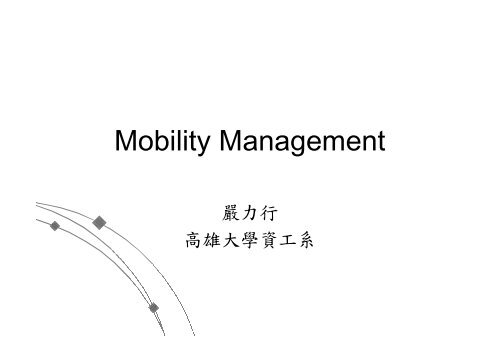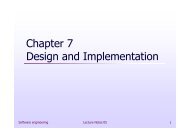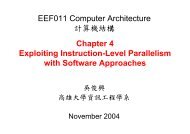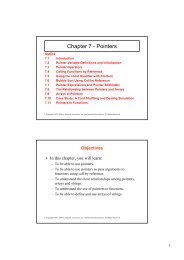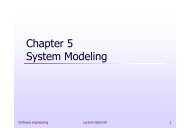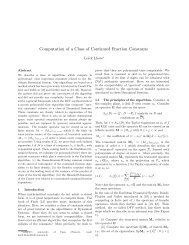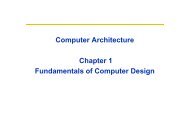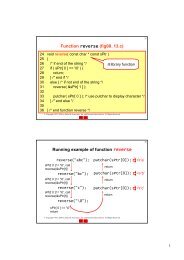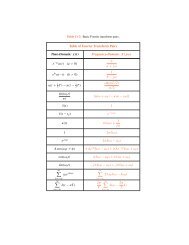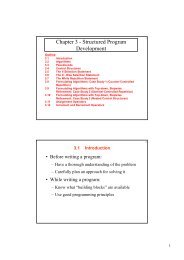Mobility Management
Mobility Management
Mobility Management
You also want an ePaper? Increase the reach of your titles
YUMPU automatically turns print PDFs into web optimized ePapers that Google loves.
HLR and VLR•HLR (Home Location Register)•aa database to store and managementpermanent data of subscribers•VLR (Visitor Location Register)•aa database to store temporary informationabout subscribers•needed by MSC in order to service visitingsubscribers
GSM Registration Procedure1: old TMSI + oldVLR id2: TMSIIMSIIMSI3: location update4: new TMSI5: registrationcancellationVLR5HLR2143VLR
Call Delivery for MobileTerminated Callrequest roaming numberdial MSISDN1 1otherswitchesGMSC(INTX)3routing12otherswitchesHLR312allocate MSRNVLRMSC3 pagingMS
Registration Area• Beside periodic registrations, MT will perform alocation update whenever it crosses theboundary of a registration/location area• Registration/Location Area (RA/LA)• consists of one or more cells• the basic unit of registration/pagingregistrationpaging
Registration Area Planning• Tradeoff between location update cost andpaging cost• Big RA means high paging cost but low locationupdate cost• Small RA means low location update cost but highpaging costCostTotalcell RA VLR PLMN GSM Size of RAPagingLocation update
Hand-off (Hand-over)Switches andProcessorHand-off (Hand-over):switches cellsCell #1 Cell #2
Handoff <strong>Management</strong>•Ongoing calls are modified under twoconditions: signal strength deteriorationand user mobility•intra-cell and inter-cell handoffs•within and between cells•soft handoff and hard handoff•without and with interruptions in radio links
Who Initiates the Handoff?•NCHO(Network-controlled handoff) orMAHO (Mobile-assisted Handoff)•the networks generates a new connection,finding new resources for the handoff andperforming any additional routing operations•MCHO(Mobile-controlled handoff)•the MT finds the new resources and thenetwork approves
Three Classes of Handoffs inGSMMSCMSCBSCBSCBSCBTS BTS BTSBTSMSMS1. different BTS, same BSCMSMS2. different BSC, same MSCMSMS3. different MSC, same PLMN(old MSC=anchor MSCnew MSC=relay MSC)
•Call drop rateTechnical Terms•The probability that an ongoing call is droppeddue to handoff•Call blocking rate•The probability that a new call is denied dueto lack of available channel•call drop rate is usually more importantthan call blocking rate
Handoff <strong>Management</strong>:Channel Reservation Scheme•Reserve some channels in BTS forhandoff calls•Trade call blocking rate for call drop rateA new call in thisBTS will be deniedif all non-reservedchannels are in useHowever, a handoffcall can still use areserved channelIn useIn use…for both newcalls andhandoff callsReserved forhandoff callsChannels in a BTS
<strong>Mobility</strong> <strong>Management</strong> inIP over WLAN Environment
DHCPServer 1L2H and L3HSubnet1Internet/IntranetSubnet2DHCPServer 2AP 1 AP 2orRouterassociationWSL2H: change of WS’s association from one AP to anotherL3H: change of WS’s network-layer setting
General Handoff PhasesL2HL2H ExecutionL2H DetectionProbing Authentication AssociationL3HL3H ExecutionL3H DetectionDHCP DAD IP Config.
L2H ExecutionWSAPActive or Passive ScanningAuthentication RequestAuthentication ResponseAssociation RequestAssociation ResponseProbing802.11AuthenticationAssociation802.1X (Optional)802.11i (Optional)
L2H Detection• Detect the need to start an L2H (probing)• Various methods• RSSI• Bit error rate• Frame error rate• should differentiate intermittent badcommunication state from persistent one thatnecessitates an L2H• Detection time can’t t be too short!
Inter-ESS L2H?•L2Hs within an ESS are intrinsicallysupported•802.11 does not specify how to perform aninter-ESS L2H (ESS transition)ncnu ncnu hinetESSIDIntra-ESS L2HInter-ESS L2H
Enabling ESS Transition• By default, only APs belonging to the currentESS are considered in the probing phase• By specifying the designated ESSID in ProbeRequest• If no such AP can be found, the probing will failand link-down eventually arises• When ZeroConfig, a Windows XP module,receives link-down event, it will instruct L2module to switch to another ESS (enabling ESStransition)
Layer-3 3 Handoff (L3H)• Needed when the new and previous APs belongto different network domains• Should renew network-layer settings (IP address,default gateway, etc.)subnet1140.127.5.* Router140.127.7.*subnet2No L3H is needed L3H is needed
L3H Execution•Typical L3H execution•Dynamic Host Configuration Protocol (DHCP)•Duplicated Address Detection (DAD)•IP Configuration•Station’s s IP address changes after an L3H•Ok for most application•If want to retain IP address, Mobile IP shouldbe used
CISCOSYSTEMSCISCOSYSTEMSHierarchical Addressing in theInternet•Address implies locationSubnet A140.126.5.*161.12.53.*213441864112Subnet B
IP Routing• Router uses routing table to direct packets tothe appropriate interfaceTarget Interface2.0.0.0/24 a3.0.0.0/24 b4.0.0.0/24 cab3.0.0.2 3.0.0.3 3.0.0.4Dest = 3.0.0.4Routerc4.0.0.5 4.0.0.6
CISCOSYSTEMSCISCOSYSTEMSWhen a Node Roams toAnother Subnet•How to retain its connections?Subnet A140.126.5.*161.12.53.*213441864112Subnet B
Traditional Routing for a MobileHost• Host moving to another network is unreachableTarget Interface2.0.0.0/24 a3.0.0.0/24 b4.0.0.0/24 cab3.0.0.2 3.0.0.3 3.0.0.4XDest = 3.0.0.4Routerc4.0.0.5 4.0.0.6MobileHost3.0.0.4
Potential Strategies for MobileNodes•if a node roaming in another subnetwishes to retain its connections, it can•use a new IP address (e.g., using DHCP)•not transparent to transport layer (TCP/UDP)•exploit host-specific specific route•poor scalability•use Mobile IP
CISCOSYSTEMSCISCOSYSTEMSUse A New IP Address• Current TCP protocol stack must be modifiedSubnet A140.126.5.*161.12.53.*21348441864Subnet B
Change the Node’s s IP Address• A TCP connection within a node is uniquelyidentified by the following four values• IP Source Address• IP Destination Address• TCP Source Port• TCP Destination Port• TCP checksum is computed using these fourfields in addition to the data in the payload of thesegment.
Host-Specific RoutesTarget Interface2.0.0.0/24 a3.0.0.4/32 c3.0.0.0/24 b4.0.0.0/24 canot scaleable since updates andunique entries would be neededfor every mobile hostb3.0.0.2 3.0.0.3 3.0.0.4Dest = 3.0.0.4Routerc4.0.0.5 4.0.0.6MobileHost3.0.0.4
Host-Specific Routes (Cont.)
Mobile IP Overview• published by IETF as a Proposed Standard inNov. 1996.• The Mobile IP standards documents include thefollowing Request For Comments (RFCs(RFCs):• RFC2002, 2003, 2004, 1701, 2005, 2006.
Requirements of Mobile IP• A mobile node must• be able to communicate with other nodes afterchanging its link-layer layer point-ofof-attachment to theInternet• be able to communicate using only its home IPaddress, , regardless of its current link-layer layer point-ofof-attachment to the Internet• be able to communicate with other computers thatdo not implement the Mobile IP mobility functions• not be exposed to any new security threats over andabove those to which any fixed node on the Internetis exposed
Mobile IP Architecture• Mobile Node (MN):: a node which can change itspoint-ofof-attachment to the Internet• Home Agent (HA):: a router with an interface on theMN’s s home link• Foreign Agent (FA):: a router on an MN’s s foreign link
<strong>Mobility</strong> Binding• Home address: : permanent address of MN• care-of-address: : MN’s s new address used inforeign area, can be•foreign agent care-of address•assigned by FA, usually the same address as theFA•co-located care-of address•obtained by MN itself through some means (e.g.,DHCP)
Operations of Mobile IP
An Analogy of Mobile IP• Mobile Node (MN): 你 。• Home Agent (HA): 你 母 親 或 其 他 家 人 。• Foreign Agent (FA): 系 上 的 助 理 小 姐 。• 當 你 在 家 時 , 寄 給 你 的 信 由 自 己 處 理 。• 當 你 出 外 唸 書 時 , 你 的 筆 友 還 是 將 信 寄 至 你 的Home Address, , 而 由 你 的 母 親 替 你 轉 寄 信 件 。• 要 讓 你 的 母 親 轉 信 , 你 必 須 告 訴 她 你 的 Care-ofAddress。
An Analogy of Mobile IP (cont.)• 如 果 是 Foreign Agent Care-of Address, , 則 你母 親 將 信 寄 至 系 上 , 由 系 助 理 轉 交 給 你 。• 如 果 是 Co-located Care-of Address, , 則 你 母 親將 信 寄 至 你 目 前 通 訊 處 , 由 你 自 己 收 信 。• 無 論 是 哪 一 種 情 形 , 你 的 筆 友 是 不 知 道 你 的Care-of Address 的 。• 你 的 Care-of Address 只 用 於 讓 你 的 HA 轉 信用 。 你 的 對 外 通 信 仍 使 用 Home Address。
Tunneling• A tunnel is the path followed by a first packetwhile it is encapsulated within the payloadportion of a second packet.TunnelHA
IP-inin-IP EncapsulationCNOriginal IP PacketOuterHeaderEncapsulated IP PacketTunnelHeaderPayloadHeaderHAPayload
Agent Discovery• Agent advertisement• Agent solicitationadvertisementsolicitationAgentadvertisementAgentMNMN
Registration and Deregistration•InformHA MN’s care-of-address•performed when•MN detects that it has moved to anothersubnet•current registration expires•FA restarts•aa lot of retransmissions in transport layer•deregistration when MN moves back home
Registration in Mobile IP MN sends registrationmessage to foreign agent foreign agent storesMN’s s link-layerlayeraddress in visitorlist foreign agentsends backregistration replyregisterMN nnAgentregister replyvisitor listnode link-layer addressn xxxxxxxxxx
Packet Delivery with ForeignAgent Care-ofof-Address CN sends packet toMNCN MN’s s Home AgentFAcaptures it andInternettunnels it toMNForeign Agent FA decapsulates the packet andforwards it to MN using MN’s s link-layer layer addressHA
Packet Delivery with Co-locatedCare-ofof-AddressCN sends packet toMNMN’s s Home AgentMNcaptures it andtunnels it to MNMNdecapsulates the packetby itselfInternetCNHA
Proxy ARP and Gratuitous ARP•Proxy ARP•replies ARP requests on behalf of other nodes•Gratuitous ARP•spontaneously causes other nodes to updatean entry in their ARP cache
When an MN registers with anFA•MN disables its own future processing ofARP requests•HA performs a gratuitous ARP on behalf ofthe MN•HA use proxy ARP to reply ARP requestsfor the MN
When an MN registers at home•MN enables its own future processing ofARP requests•MN performs a gratuitous ARP for itself•HA stops using proxy ARP for the MN•HA performs a gratuitous ARP on behalf ofthe MN
Triangle RoutingMNFAHATriangleRoutingCN
Route Optimization (Optional)MNFAOtherpacketsHAFirst packetBinding CacheHome IP CoACN
Route Optimization Issues•Security•CN收 到 關 於 MN CoA 的 訊 息 可 能 是 假 的•CN的 封 包 被 非 MN 的 第 三 者 攔 截•<strong>Mobility</strong>• 當 MN CoA 變 動 時 , 需 通 知 所 有 CN•Compatibility•CN需 實 作 封 包 Encapsulation 與 BindingCache• 與 Mobile IP 當 初 設 計 的 requirement 不 符
Conclusions•<strong>Mobility</strong> management in cellular systemssconsists of location management andhandoff management•Mobile IP is a network-layer solution toaddress mobility


